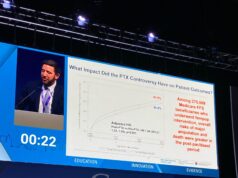 Clinical studies of paclitaxel-coated balloons and paclitaxel-eluting stents “may continue and should collected long-term safety (including mortality) and effectiveness data”, says the US Food and Drug Administration (FDA) in a letter to healthcare providers on 7 August. This is due to “the demonstrated short-term benefits of the devices, the limitations of the available data, and uncertainty regarding the long-term benefit-risk profile of paclitaxel-coated devices”.
Clinical studies of paclitaxel-coated balloons and paclitaxel-eluting stents “may continue and should collected long-term safety (including mortality) and effectiveness data”, says the US Food and Drug Administration (FDA) in a letter to healthcare providers on 7 August. This is due to “the demonstrated short-term benefits of the devices, the limitations of the available data, and uncertainty regarding the long-term benefit-risk profile of paclitaxel-coated devices”.
The letter provides an update on the agency’s stance on the use of paclitaxel devices to treat peripheral arterial disease (PAD) in the femoropopliteal arteries. The FDA say clinical studies investigating these devices in the lower leg “require appropriate informed consent and close safety monitoring to protect enrolled patients”, and confirm they are working with study investigators to modify informed consent documents to include information about the late mortality signal.
The FDA state: “Based on the conclusions of our analysis and recommendations of the advisory panel, the FDA is taking additional steps to address this signal, including working with manufacturers on updates to device labelling and clinical trial informed consent documents to incorporate information about the late mortality signal. The FDA is also continuing to actively work with the manufacturers and investigators on additional clinical evidence development for assessment of the long-term safety of paclitaxel-coated devices.”
The recommendations
In full, the FDA recommendations are:
- Continue diligent monitoring of patients who have been treated with paclitaxel-coated balloons and paclitaxel-eluting stents.
- When making treatment recommendations, and as part of the informed consent process, consider that there may be an increased rate of long-term mortality in patients treated with paclitaxel-coated balloons and paclitaxel-eluting stents.
- Discuss the risks and benefits of all available PAD treatment options with your patients. For many patients, alternative treatment options to paclitaxel-coated balloons and paclitaxel-eluting stents provide a more favourable benefit-risk profile based on currently available information.
- For individual patients judged to be at particularly high risk for restenosis and repeat femoropopliteal interventions, clinicians may determine that the benefits of using a paclitaxel-coated device outweigh the risk of late mortality.
- In discussing treatment options, physicians should explore their patients’ expectations, concerns and treatment preferences.
- Ensure patients receive optimal medical therapy for PAD and other cardiovascular risk factors as well as guidance on healthy lifestyles including weight control, smoking cessation, and exercise.
- Report any adverse events or suspected adverse events experienced with the use of paclitaxel-coated balloons and paclitaxel-eluting stents. Voluntary reports can be submitted through MedWatch, the FDA Safety Information and Adverse Event Reporting programme. Device manufacturers and user facilities must comply with the applicable Medical Device Reporting (MDR) regulations. Health care personnel employed by facilities that are subject to the FDA’s user facility reporting requirements should follow the reporting procedures established by their facilities. Prompt reporting of adverse events can help the FDA identify and better understand the risks associated with medical devices.
FDA actions
In full, the FDA actions are:
- The FDA continues to work with the manufacturers and investigators on additional clinical evidence development to assess the long-term safety of paclitaxel-coated devices. Analyses of additional randomised trials and registry datasets are being planned to provide further insights into the magnitude and potential causes of the late mortality risk.
- The FDA is working with manufacturers on labelling updates for paclitaxel-coated devices to include information about the late mortality signal.
- For ongoing trials of paclitaxel-coated devices, the FDA is working with study investigators to modify informed consent documents to include information about the late mortality signal.
Summary of earlier FDA statements
In June this year, the agency convened a Circulatory Systems Devices Panel meeting (19–20 June, Washington, DC, USA) on the late mortality safety signal associated with paclitaxel-coated balloons and paclitaxel-eluting stents used to treated PAD in the femoropopliteal arteries.
Following the two-day discussion, which included the presentation of the agency’s own analysis of long-term follow-up data from pivotal premarket randomised trials, an FDA Circulatory System Devices Panel Advisory Committee concluded that there is a “late mortality signal”, as first described in the Journal of the American Heart Association (JAHA) paper authored by Konstantinos Katsanos et al (Patras, Greece) in December 2018.
However, they also concluded that better data collection was necessary going forward, as some data were missing, a small sample size meant there were wide confidence intervals, and there was pooling of studies of different paclitaxel devices that were not intended to be combined. The panel determined that there were not enough data to confirm a class effect, and no consensus was reached on the cause(s) of death.
In their most recent letter to healthcare providers, dated 7 August 2019, the FDA summarise the deductions of the advisory committee back in June: “In the three randomised trials which enrolled a total of 1,090 patients, the crude mortality rate at five years was 19.8% (range 15.9–23.4%) in patients treated with paclitaxel-coated devices compared to 12.7% (range 11.2–14%) in subjects treated with uncoated devices. The relative risk for increased mortality at five years was 1.57 (95% confidence interval 1.16–2.13), which corresponds to a 57% relative increase in mortality in patients treated with paclitaxel-coated devices. A meta-analysis performed by VIVA (Vascular InterVentional Advances) physicians of patient-level data provided by manufacturers reported similar findings with a hazard ratio of 1.38 (95% confidence interval 1.06–1.80). […] The Panel determined, and the FDA concurs, that additional clinical study data are needed to fully evaluate the late mortality signal.”













